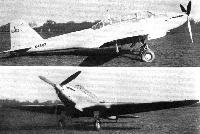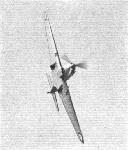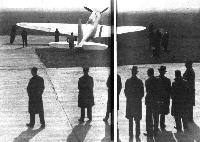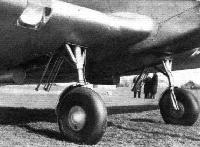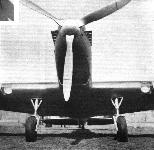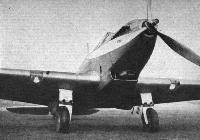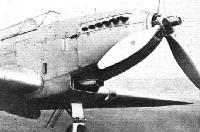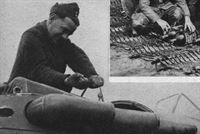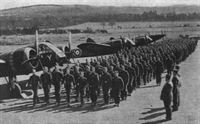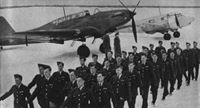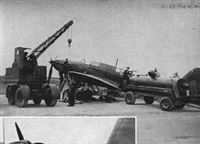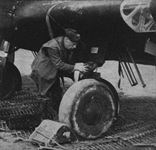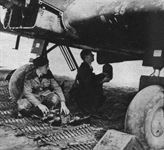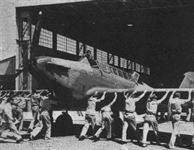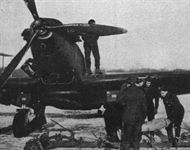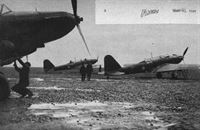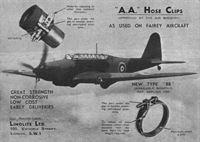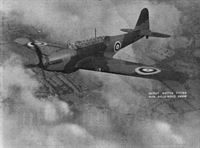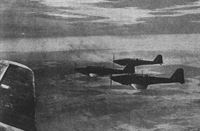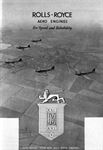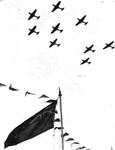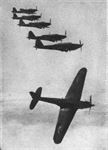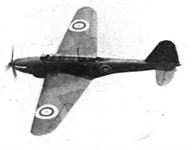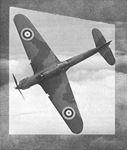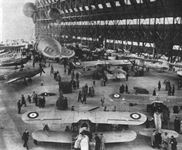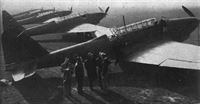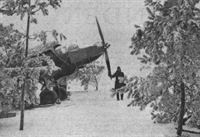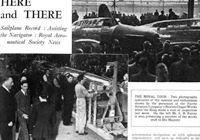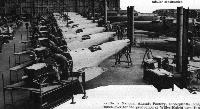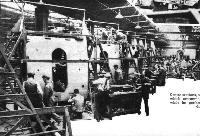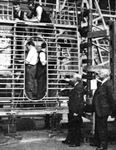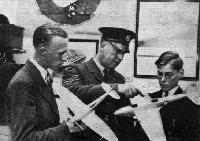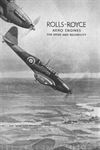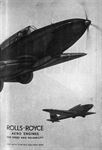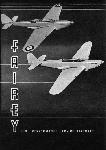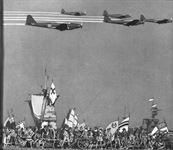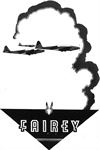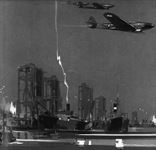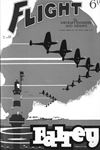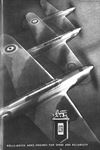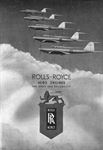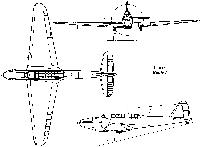
Описание
Страна : Великобритания
Год : 1936
Легкий бомбардировщик с экипажем из трех человек
Battle
Легкий бомбардировщик, одномоторный цельнометаллический моноплан. Шасси убирающееся, с хвостовым колесом. Экипаж 3 человека. Спроектирован в КБ фирмы "Фэйри авиэйшн" под руководством М.Лобеля. Первый полет совершил 10 марта 1936 г. Серийный выпуск начался с апреля 1937 г. на заводах "Фэйри" (Стокпорт) и "Остин моторс" (Бирмингэм). Всего построено 2201 экз. Мотор "Мерлин" I/II/III/V, вооружение 2x7,69 (полевые переделки - 3x7,69), бомбы до 454 кг.
Состоял на вооружении в Великобритании с мая 1937 г., в Бельгии - с марта 1936 г., в Турции - с сентября 1939 г., в Греции - с декабря 1939 г., в ЮАС - с августа 1940 г., а также использовался как учебный с 1940 г. в Австралии, Канаде, Индии и Новой Зеландии.
Выпускались два основных варианта:
- для английских ВВС;
- экспортный для Бельгии с удлиненными воздухозаборниками и иной выхлопной системой.
Выпускались также несколько учебных модификаций и вариант буксировщика мишеней-рукавов.
С сентября 1939 г. "бэттлы" британского экспедиционного корпуса во Франции начали вести разведку приграничных районов Германии. В мае - июне 1940 г. эти самолеты широко использовались в боях во Франции и Бельгии, до конца октября они наносили удары из Англии по побережью Франции, Германии и Нидерландов. С ноября почти все "бэттлы" были переданы в учебные части или проданы за границу. Как морские разведчики они продолжали летать с баз в Исландии до июня 1941 г.. Бельгийские самолеты приняли участие в обороне страны в мае 1940 г., греческие с октября 1940 г. действовали против итальянских войск в Албании, в апреле 1941 г. - против немцев. Южноафриканские "бэттлы" с августа 1940 г. воевали с итальянцами в Восточной Африке (до середины августа 1941 г.)
"Бэттл" сняли с производства в ноябре 1940 г. Как учебный самолет он использовался до конца войны в Англии, ЮАС, Канаде. Греческие и бельгийские машины полностью уничтожены в ходе боевых операций.
"Бэттл" I||
Размах:||16,46 м
Длина:||15,4 м
Моторы, количество х мощность:||1x1030 л.с.
Взлетная масса, максимальная:||4900 кг
Максимальная скорость:||386 км/ч
Практический потолок:||7180 м
Дальность:||1680 км
Описание:
- Battle
- Fairey Battle
- Flight, March 1936
POSTERITY ... SHALL HEAR of these BATTLES - Flight, November 1939
Britain's Military Aircraft
Фотографии
-
АвиаМастер 2002-01 / В.Котельников - Проигравший битву /Монография/
"Бэттл" из 12-й эскадрильи RAF. 12 мая 1940г. самолет был сбит при попытке атаковать мост в Маастрихте.
-
История Авиации 2002-03 / И.Сеидов - Оружие смелых /Маленькие эпизоды больших войн/ (3)
"Бэттл" Mk.I командира звена "B" флаинг офицера Гарланда из состава 12-й эскадрильи Передовых Ударных ВВС.
-
Мировая Авиация 151
Регистрационный номер: P2204 Battle из 12-й эскадрильи понесли тяжелые потери в боях во Франции. Эскадрилье, первоначально летавшей на разведку и сброс листовок, затем поручили наносить бомбовые удары по наступающей немецкой армии.
-
АвиаМастер 2002-01 / В.Котельников - Проигравший битву /Монография/
"Бэттл" из 142-й эскадрильи RAF, сбитый в мае 1940-го над Сен-Ламбером.
-
АвиаМастер 2002-01 / В.Котельников - Проигравший битву /Монография/
Регистрационный номер: K9246 "Бэттл" из 103-й эскадрильи RAF, сбитый 10 мая 1940г. над Люксембургом.
-
Air Enthusiast 1972-08 / H.Taylor - The Battle and the Nomad /Viewed from the Cockpit/
Регистрационный номер: K7639 Fairey Battle I (K7639) of No 106 Sqdn, RAF, Abingdon, Oxon, August 1938.
-
АвиаМастер 2002-01 / В.Котельников - Проигравший битву /Монография/
"Бэттл" из 3-го полка бельгийских ВВС, сбитый 10 мая 1940г. при атаке на мост через канал Альберта.
-
Air Enthusiast 1972-08 / H.Taylor - The Battle and the Nomad /Viewed from the Cockpit/
Fairey Battle I (T63) of the 5 escadrille, Groupe III, 3 Regiment of the Belgian Aeronautique Militaire at Evere-Bruxelles, May 1940 (note different exhaust stubs, lenghtened radiator bath and shallower aft canopy decking).
-
АвиаМастер 2002-01 / В.Котельников - Проигравший битву /Монография/
"Бэттл" из 33-й эскадрильи ВВС Греции, март 1941г.
-
Air Enthusiast 1972-08 / H.Taylor - The Battle and the Nomad /Viewed from the Cockpit/
Fairey Battle I (B282) of the 33 Mira Vomvardismou (Bomber Squadron) of the Royal Hellenic Air Force, October 1940.
-
Air Enthusiast 1972-08 / H.Taylor - The Battle and the Nomad /Viewed from the Cockpit/
Fairey Battle I (953) of the No 15 Sqdn, South African Air Force, Algato, East Africa, July 1941.
-
АвиаМастер 2002-01 / В.Котельников - Проигравший битву /Монография/
Буксировщик мишеней из 5-й школы штурманов-бомбардиров и воздушных стрелков, Канада, 1941г.
-
Air Enthusiast 1972-08 / H.Taylor - The Battle and the Nomad /Viewed from the Cockpit/
Fairey Battle T (1696) of No 8 Service Flying Training School, Moncton, Canada, mid-1943.
-
Air Enthusiast 1972-08 / H.Taylor - The Battle and the Nomad /Viewed from the Cockpit/
Регистрационный номер: R7365 [2] Fairey Battle T (R7365), RAF, September 1941.
-
Мировая Авиация 151
Регистрационный номер: R7365 [2] Около сотни поздних серийных Battle стали учебными Battle T - с дублированным управлением в раздельных кабинах. При этом пришлось довольно сильно переделать проводку управления и фюзеляж.
-
Air Enthusiast 1972-08 / H.Taylor - The Battle and the Nomad /Viewed from the Cockpit/
Fairey Battle T (1966) of No 3 Bombing and Gunnery School, MacDonald, Canada, 1943 (note original camouflage showing through yellow finish beneath the turret.
-
Мировая Авиация 123
Этот учебно-тренировочный самолет Battle (T) в 1943 году принадлежал 3-й школе подготовки бомбардиров и воздушных стрелков (Макдональд, Канада).
-
АвиаМастер 2002-01 / В.Котельников - Проигравший битву /Монография/
Регистрационный номер: K4303 [29] -
Flight 1937-06 / Flight
Регистрационный номер: K4303 [29] -
Flight 1936-03 / Flight
Регистрационный номер: K4303 [29] A LA MODE: The veil of official secrecy has been partially lifted from the shapely Fairey bomber monoplane, known as the Battle. Its engine is one of the new Rolls-Royce "Merlins"; its covering of metal; its undercarriage semi-retractable; and its performance, if known, a State secret.
-
Flight 1936-12 / Flight
Регистрационный номер: K4303 [29] APPROACH TO A PROBLEM - 1: This view of the Fairey Battle medium bomber (1,065 h.p. Rolls-Royce Merlin) affords an interesting comparison with the Armstrong Whitworth machine intended for similar duties. Note the revised cockpit enclosure and undercarriage and the D.H. v.p. airscrew.
-
Aeroplane Monthly 1986-02 / ??? - Golden Anniversary
Регистрационный номер: K4303 [29] The prototype Battle taking off from Hayes (Fairey's Great West aerodrome) in March 1936.
-
Aeroplane Monthly 1983-04 / B.Gunston - The classic aero engines (6)
Регистрационный номер: K4303 [29] -
Jane's All the World Aircraft 1938 / 03 - All the world's aeroplanes
Регистрационный номер: K4303 [29] The Fairey "Battle" Two-seat Day Bomber (Rolls-Royce "Merlin" engine).
-
Flight 1936-05 / Flight Advertisements
Регистрационный номер: K4303 [29] FAIREY "BATTLE" THE NEW ULTRA HIGH SPEED TWO-SEATER MEDIUM BOMBER FITTED WITH ROLLS-ROYCE ENGINE
-
АвиаМастер 2002-01 / В.Котельников - Проигравший битву /Монография/
Регистрационный номер: K4303 [29] Первый прототип "Бэттла" - воплощенная элегантность.
-
Flight 1936-03 / Flight Advertisements
Регистрационный номер: K4303 [29] -
Flight 1937-05 / Flight
Регистрационный номер: K4303 [29] The Fairey Battle medium bomber is a two-seater with the Rolls-Royce Merlin engine, and has been ordered in large numbers for the R.A.F.
-
Flight 1936-04 / Flight
Регистрационный номер: K4303 [29] -
Flight 1937-03 / Flight Advertisements
Регистрационный номер: K4303 [29] -
Flight 1936-04 / Flight
Регистрационный номер: K4303 [29] -
Flight 1936-04 / Flight
Регистрационный номер: K4303 [29] -
Flight 1936-03 / Flight
Регистрационный номер: K4303 [29] -
Flight 1938-01 / Flight Advertisements
Регистрационный номер: K4303 [29] -
Aeroplane Monthly 1986-02 / ??? - Golden Anniversary
Регистрационный номер: K4303 [29] В отличие от прототипа (на снимке) на серийных самолетах не было кока винта - итог выбора воздушного винта марки DH.
The prototype Battle photographed by Charles E. Brown over the Fairey flight hangar at the Great West Aerodrome, Hayes in March 1936. K-1303 made its first flight in the hands of Chris Staniland.
THE WORLD'S FASTEST BOMBER: Inspecting the Fairey Battle from stem to stern one finds: three-bladed Fairey airscrew; supercharged Rolls-Royce Merlin; small abdominal radiator, possibly denoting high-temperature cooling; internal landing lights; semi retractable undercarriage; complete cockpit enclosure; and cantilever tail plane. The covering is a stressed metal skin. All these features are visible in this view of Flt. Lt. Christopher Staniland "posing" the Battle over Heath Row. -
Air Pictorial 1999-10
Регистрационный номер: K4303 [29] The Battle prototype, K4303, shortly before being shown at the RAF Display in June 1936. It made its first flight in the hands of Chris Staniland from Fairey’s Great West aerodrome on March 10, 1936.
-
Aeroplane Monthly 1986-02 / ??? - Golden Anniversary
Регистрационный номер: K4303 [29] Press viewing of the prototype Battle at Fairey's Hayes aerodrome on March 30, 1936. Note three-bladed, fixed-pitch Fairey Reed propeller and early type canopy.
-
Flight 1936-07 / Flight
Регистрационный номер: K4303 [29] Three of the Fairey Battle's notable features are apparent here. They are the V.P. airscrew, the new "glasshouse" and the flaps.
-
Aeroplane Monthly 1974-09 / ??? - Hendon Pageantry 1920-37
Регистрационный номер: K4303 [29] The shape of wings to come. Monoplanes fill the new types park at the 1936 pageant.
Другие самолёты на фотографии: Armstrong Whitworth Whitley / A.W.38 - Великобритания - 1936Supermarine Spitfire - Великобритания - 1936Vickers Venom - Великобритания - 1936Vickers Wellington / Type 271 - Великобритания - 1936Westland Lysander - Великобритания - 1936
-
Aeroplane Monthly 1986-12 / A.Lumsden, T.Heffernan - Probe Probare (30)
Регистрационный номер: K4303 [29] The prototype Battle photographed shortly after completion, minus paint and roundels. K4303 later passed to a maintenance unit.
-
Flight 1936-03 / Flight
Регистрационный номер: K4303 [29] Some idea of the beautiful plan form of the Fairey Battle may be gathered from this three-quarter rear view.
-
Flight 1937-06 / Flight
Регистрационный номер: K4303 [29] The Fairey Battle is the latest single-engined bomber to go into service. Its engine is the glycol-cooled R.-R. Merlin I, which gives it a top speed of 257 m.p.h.
-
Flight 1936-03 / Flight
Регистрационный номер: K4303 [29] All control surfaces of the Battle are fabric covered. The rest of the machine has a metal skin. The trimming tabs can be seen on the left, while the other shows a student of design doing poojah to the trailing-edge flaps.
-
Flight 1940-05 / Flight
At an aircraft repair depot. A rigger attending to the tail controls of a Battle.
-
Flight 1936-03 / Flight
The undercarriage of the Fairey Battle retracts upwards and backwards into recesses in the wings. A fairing helps to streamline the uncovered portion of the wheel.
-
Flight 1937-06 / Flight
An uncowled Rolls-Royce Merlin engine in a production Fairey Battle reveals the down-facing carburettor in-take with its scoop, the separate radiators and details of mounting.
-
Flight 1940-05 / Flight
Under cover. More serious overhauls and repairs are done in workshops specially erected or in buildings leased locally
-
Flight 1938-05 / Flight
During certain periods ground personnel are expected to work in their gas masks to accustom them to the “feel.”
-
Flight 1936-03 / Flight
Регистрационный номер: K4303 [29] Single-strut cantilever wheel suspension is a feature of the Fairey Battle. Note the orientable landing lights in the leading edge. The Fairey three-bladed airscrew is of small diameter so that a low undercarriage can be used.
-
Aeroplane Monthly 1986-12 / A.Lumsden, T.Heffernan - Probe Probare (30)
Регистрационный номер: K4303 [29] The Battle prototype, K4303, showing off its simple undercarriage and fixed-pitch metal propeller in the spring of 1936.
-
АвиаМастер 2002-01 / В.Котельников - Проигравший битву /Монография/
Бравый английский летчик, готовый встать на защиту интересов Британской империи.
-
Flight 1937-06 / Flight
Tho location of such items as radiator, undercarriage and landing lights are shown in this view of the nose of a Battle. The clean installation of the 990/1,050 h.p. Merlin is noteworthy.
-
Flight 1937-06 / Flight
The finished product faired and cowled. The latest type of exhaust manifold, shown in the first illustration, may be compared with the more familiar stubs seen below.
-
Flight 1938-05 / Flight
Handley Page Harrow bombers of No. 115 Squadron taxying in after a cross-country flight. The nose of a Battle gives a decorative touch.
Другие самолёты на фотографии: Handley Page Harrow / H.P.54 - Великобритания - 1936
-
Flight 1938-12 / Flight
The De Havilland variable-pitch three-blader (Hamilton licence) as fitted on the Rolls-Royce Merlin engine of the Fairey Battle.
-
Aeroplane Monthly 1986-12 / A.Lumsden, T.Heffernan - Probe Probare (30)
Регистрационный номер: K7558 [11] The original propeller and exhaust installation on Battle K7558, as seen here, was changed for later Martlesham trials with the addition of a spinner and ejector-type manifolds.
-
Aeroplane Monthly 1986-12 / A.Lumsden, T.Heffernan - Probe Probare (30)
The new installation produced better performance and night-flying visibility - although fitting and adjusting the propeller was a headache.
-
Flight 1940-05 / Flight
Come rain come snow, ten hour, twenty hour or one hundred and twenty hour inspections must be carried out.
-
Aeroplane Monthly 1983-04 / B.Gunston - The classic aero engines (6)
Регистрационный номер: K4303 [29] The view shows the D.H. variable-pitch airscrew and the retractable undercarriage.
The 25th Merlin I powered the Fairey Battle prototype, K4303, and drove a three-bladed, fixed pitch Fairey-Reed propeller. Rolls-Royce's first orders for the Merlin were for the Battle. -
Air Pictorial 1999-10
For night operations, these 12 Sqn aircraft have shields to reduce exhaust glare for the pilot and the centre portion of the glazed cockpit has been painted over to help the work of the bomb-aimer/observer.
-
АвиаМастер 2002-01 / В.Котельников - Проигравший битву /Монография/
"Бэттлы" 12-й эскадрильи RAF. Обратите внимание на самодельные щитки над выхлопными патрубками, предохранявшие пилотов от ослепления пламенем выхлопа в ночных полетах.
-
Aeroplane Monthly 1986-12 / A.Lumsden, T.Heffernan - Probe Probare (30)
Регистрационный номер: K7558 [11] Another view of K7558, taken during trials.
-
Flight 1940-05 / Flight
Maintenance in the field. All simple adjustments, greasing and cleaning were carried out at the advanced aerodromes in France during the early part of 1940, when this photograph was taken.
-
Air Enthusiast 2001-11 / D.Garcia - Air Force on the Edge
RAF Battle at Evere.
-
Aviation Historian 29 / G.Baughen - 1939. Was the RAF ready to war?
Designed to Specification P.27/32 for a single-engined day bomber, the Fairey Battle entered RAF service in May 1937. Originally conceived as a bomber able to reach Paris, it was hopelessly ill-equipped to be able to shift its focus to targets in Germany; as a strategic bomber it was an abject failure - but it had potential as a short-range tactical bomber.
-
Flight 1937-09 / Flight
The Fairey Battles are lined up on Upwood aerodrome.
-
Air-Britain Aeromilitaria 1983-03
In 1976, Aeromilitaria had an article on Penrhos airfield but this was in pre-photo days. This was taken in August 1940 at No.9 Bombing & Gunnery School and show the unit's Battles.
-
Jane's All the World Aircraft 1938 / 02 - The progress of the world in military aviation during the year 1937-38
Two Squadrons of Fairey "Battle" Light Bombers (Rolls-Royce "Merlin") lined up at one of the new R.A.F. aerodromes. The pilots are in the foreground and other members of the crews in front of their machines.
-
Aeroplane Monthly 1991-01 / W.Smith - The Battle within
Fairey Battles at Trenton, Canada in April 1940.
-
Flight 1938-04 / Flight
"IT WAS A FAMOUS VICTORY." The Battle and the Blenheim make an appropriate background for the aircraft apprentices of Halton. The officers' mess is in the distance.
Другие самолёты на фотографии: Bristol Blenheim - Великобритания - 1936
-
Aeroplane Monthly 1989-06 / J.Meadows - A Decisive Factor (5)
This scene was typical at Canadian bases during the war. Twenty-seven young Canadians have received their wings and now they march past their training aircraft, the Fairey Battle and Airspeed Oxford. The uniform of the RCAF was practically the same as that of the RAF, except that it had the letters RCAF cast into the buttons, and the same letters were woven into the pilots' wings. The word “Canada" was sewn on to tunic shoulders.
Другие самолёты на фотографии: Airspeed Oxford / AS.10 - Великобритания - 1937
-
Flight 1940-04 / Flight
Complete with wings. The twenty-seven pilots shown on p. e march past their training machines, the Fairey Battle and the Airspeed Oxford.
Другие самолёты на фотографии: Airspeed Oxford / AS.10 - Великобритания - 1937
-
Flight 1940-04 / Flight
A GREAT MOMENT. Twenty-seven young Canadians receive their "wings" at a Canadian air base.
This scene was typical at Canadian bases during the war. Young men receive their wings, while around them stand Fairey Battles, a Harvard and an Oxford.Другие самолёты на фотографии: Airspeed Oxford / AS.10 - Великобритания - 1937North American T-6 Texan / AT-6 Harvard - США - 1935
-
Jane's All the World Aircraft 1938 / 02 - The progress of the world in military aviation during the year 1937-38
A formation of Fairey "Battle" Bombers (Rolls-Royce "Merlin") of the Belgian Military Air Force.
-
История Авиации 2002-03 / И.Сеидов - Оружие смелых /Маленькие эпизоды больших войн/ (3)
Для экипажей британских и бельгийских легких бомбардировщиков "Бэттл" осень и зима 1939-1940гг. прошли сравнительно спокойно, но в мае-июне 1940г. их ждали тяжелые испытания.
-
АвиаМастер 2002-01 / В.Котельников - Проигравший битву /Монография/
Зимой 1939-1940 годов в северной Франции выпал снег. Интенсивность полетов резко снизилась.
-
Flight 1940-06 / Flight
An Amiot 143 of an unidentified Escadre with a Fairey Battle of the Advanced Air Striking Force shortly before the Wehrmacht assault in the spring of 1940.
Другие самолёты на фотографии: Amiot Amiot 140 / Amiot 143BN5 - Франция - 1931
-
Flight 1940-06 / Flight
Переброска осенью 1939г. на континентальные аэродромы сравнительно небольшого количества английских самолетов фактически лишь ненамного облегчила положение французских ВВС.
Morane MS 406 fighters parked near Battles during a co-operation exercise.Другие самолёты на фотографии: Morane-Saulnier MS.405/406/410C1 - Франция - 1935
-
Flight 1939-12 / Flight
MIXED GRILL IN CANADA: The Canadian type of De Havilland Tiger Moth, the Fairey Battle, North American Harvard, Westland Lysander and Airspeed Oxford are all in use in the R.C.A.F. and are represented in this group. The Lysander is built in Canada but the Battles and Oxfords were imported from England.
Другие самолёты на фотографии: Airspeed Oxford / AS.10 - Великобритания - 1937De Havilland Tiger Moth / D.H.82 - Великобритания - 1931North American T-6 Texan / AT-6 Harvard - США - 1935Westland Lysander - Великобритания - 1936
-
Aeroplane Monthly 1989-04 / J.Meadows - A Decisive Factor (3)
Typical of RCAF stations during the period of the Empire air training scheme is this one above at Ontario, photographed in 1940 with a parade in progress. In the background may be seen Fairey Battles and a couple of Westland Wapitis.
Другие самолёты на фотографии: Westland Wapiti - Великобритания - 1927
-
Мировая Авиация 151
Зимой 1939-1940 годов экипажи столкнулись с суровыми метеоусловиями. Обильные снегопады заваливали взлетно-посадочные полосы Северной Франции, мешая полетам несколько недель.
-
Flight 1940-05 / Flight
A new patient. Surrounded by the customary paraphernalia a Battle awaits treatment at an aircraft park.
-
Flight 1940-05 / Flight
Retractable undercarriages require to be kept clean. Note the iron grids to defeat mud.
-
Flight 1940-05 / Flight
Re-equipping a machine with a fresh supply of oxygen. Cylinders of oxygen must be carried on any operation involving a height of 20,000 ft. or over.
-
Flight 1939-11 / Flight
In France the Battles are camouflaged while on the ground by special nets or are screened by trees or haystacks. The view shows a typical scheme.
-
Flight 1940-02 / Flight
Manhandling a Fairey Battle into its hangar at Water Kloof, Pretoria.
-
Flight 1940-12 / Flight
"Bombing-up" a Fairey Battle (Merlin).
-
Aeroplane Monthly 1991-01 / W.Smith - The Battle within
Регистрационный номер: K7608 [2] Fairey Battle K7608 of 52 Squadron at RAF Northolt on May 9, 1938. The unit received its first Battles in November the previous year and flew them until May 1940. K7608 was delivered to the RCAF in February 1942.
-
Aviation Historian 11 / R.Pegram - Folland's Forgotten Monoplanes (3)
Регистрационный номер: K7608 [2] Specification P.27/32, to which Folland was broadly working for his piggyback bomber, ultimately resulted in a production contract for the similar but slightly larger Fairey Battle, which entered RAF service in May 1937.
-
Aeroplane Monthly 1986-02 / ??? - Golden Anniversary
Регистрационный номер: K7612 Battle K7612 of 52 Squadron taxying out at RAF Northolt in May 1938.
-
Flight 1940-05 / Flight
Fairey Battles, which have given such excellent service in the field, awaiting attention.
-
Aeroplane Monthly 1979-05 / F.Adkin - Memoirs of Aircraftsman (5)
Battles of 12 Squadron taking off from Andover in May 1938. This unit went to France in September 1939 as part of the Advanced Air Striking Force.
-
Aeroplane Monthly 1986-12 / A.Lumsden, T.Heffernan - Probe Probare (30)
Регистрационный номер: K7558 [11] Fairey Battle K7558 again, showing how the rearward retracting undercarriage left the wheels protruding slightly to minimise damage following a wheels-up landing.
-
Flight 1937-08 / Flight
Регистрационный номер: K7558 [11] Battle K7558 was the first production aircraft and was sent to both Martlesham Heath and Farnborough for evaluation. In August 1940 it was damaged beyond repair in a forced landing near Tiverton, Devon.
-
Flight 1939-03 / Flight Advertisements
The Battle is typical modern stressed-skin type.
-
Flight 1938-08 / Flight Advertisements
Регистрационный номер: K7558 [11] -
Aeroplane Monthly 1986-12 / A.Lumsden, T.Heffernan - Probe Probare (30)
Регистрационный номер: K7558 [11] The first production Fairey Battle, K7558, photographed in July 1937. Following A&AEE and RAE trials, this Battle flew with a general reconnaissance unit at Exeter until damaged beyond repair while landing near Tiverton, Devon on August 27, 1940.
-
Aeroplane Monthly 1991-01 / W.Smith - The Battle within
Регистрационный номер: L5664 Battle L5664 was initially used by No 2 Anti-Aircraft Co-operation Unit before being issued to the South African Air Force.
-
Aeroplane Monthly 1991-01 / W.Smith - The Battle within
Регистрационный номер: K7650 [4] Battle K7650 of 63 Squadron.
-
Flight 1938-05 / Flight
Регистрационный номер: K7650 [4] The Fairey Battle with a single Rolls-Royce Merlin II
-
Aeroplane Monthly 2000-08 / J.Golley - One of the Few. Pat Hancock /Battle of Britain survivors/
Регистрационный номер: K7650 [4] 63-я эскадрилья британских ВВС использовала Battle Mk I для подготовки летчиков экипажей Battle (авиабаза Бенсон, ноябрь 1939 года).
Fairey Battle K7650 63-M of No 63 Sqn photographed early in 1938.
Although the Fairey Battle could deliver twice as many bombs twice as far as the types it replaced, the Hawker Hart and Hind biplane bombers, it was nevertheless easy prey for the new generation of monoplane fighters; a lesson learned the hard way during the early days of the Second World War. -
Flight 1938-05 / Flight
FAIREY BATTLE: Bomber (Rolls-Royce Merlin II engine - 1,050 h.p. at 16,250ft.); span, 54ft.; gross weight, 10,775 lb.; max. speed, 257 m.p.h. at 15,000ft.
-
Air Pictorial 1999-10
Регистрационный номер: K9353 Three No 218 Sqn Fairey Battles, coded HA, formate for the official photographer just after transferring to France. Only the leading aircraft would survive, being returned to the UK in March; the other two were shot down during operations in May 1940.
-
Flight 1939-11 / Flight
A flight of Battles at formation practice.
-
Flight 1940-05 / Flight
BATTLE FORMATION: Fairey Battle bombers which have been harassing the enemy in company with Blenheims and Lysanders. Whitley, Wellington and Hampden bombers have also been attacking heavily from bases farther from the Front.
-
Aeroplane Monthly 1986-02 / ??? - Golden Anniversary
Регистрационный номер: K7662 [3], K7674 [3], K7677 [3] Another view of the trio of 12 Squadron Battles taken during a flight from Andover in May 1938. They are K7674, K7677 and K7662.
-
Flight 1938-05 / Flight
The graceful lines of the Fairey Battle are shown to advantage in this view of a flight of No. 12 (Bomber) Squadron, Andover.
-
Мировая Авиация 151
На фотографии - три бомбардировщика Battle в 1937 году. Два года спустя, 20 сентября 1939 года, бортстрелок с Battle сбил Bf 109 - первая победа британских летчиков во Второй мировой войне. Battle стал и первым принятым на вооружение самолетом с мотором Merlin.
Fairey Battles of No 12 Squadron based at RAF Andover. The first Battles entered RAF service with 63 Squadron in May 1937. -
АвиаМастер 2002-01 / В.Котельников - Проигравший битву /Монография/
Осенью 1938-го на "Бэттлах" сменились опознавательные знаки - с кокард исчезли демаскирующие белые и желтые круги.
-
Aviation Historian 25 / G.Baughen - The case for appeasement?
A formation of six Battles photographed during the period of the “Phoney War" in November 1939.
One of the RAF’s more advanced machines in 1938, the single-engined Fairey Battle light bomber could carry twice as many bombs twice as far as the Hawker Hind it replaced. The Battle entered RAF service in May 1937, but was also - rather mysteriously - excluded from the total bomb-lift figure for the RAF presented in 1938. -
Flight 1937-09 / Flight
"Echelon stepped up" is a most tricky formation, but in the picture the young pilots of No. 63 (Bomber) Squadron are doing very well.
-
Flight 1937-09 / Flight
A flight of Fairey Battles in formation. This picture shows the plan view of the machine as it would appear to diving fighters in air exercises.
-
Flight 1937-09 / Flight
Shadow-shading helps to make an aeroplane inconspicuous when seen from above with the earth as a background, but against a white cloud the machines stand out vividly.
-
Flight 1937-09 / Flight
With its wheels retracted and almost entirely concealed, the Battle is as clean as any aeroplane in the skies. Its top speed is given by the manufacturers as 257 m.p.h.
-
Flight 1938-07 / Flight
There was a strong Service support; here are Fairey Battles of No. 218 (B) Squadron from Boscombe Down.
-
Jane's All the World Aircraft 1938 / 02 - The progress of the world in military aviation during the year 1937-38
A formation of Fairey "Battles" (Rolls-Royce "Merlin") flying over fog in Berkshire.
-
Aeroplane Monthly 1979-05 / F.Adkin - Memoirs of Aircraftsman (5)
Регистрационный номер: K7674 [3], K7677 [3] Three Battles of 12 Squadron, K7674 and K7677 nearest, up from RAF Andover in May 1939.
-
Flight 1940-03 / Flight
FRIENDLY FAIRIES: The line-astern formation may have more than a tactical significance. Battles on patrol in France.
-
Flight 1940-05 / Flight
Hawker Hurricane eight-gun fighters as seen from the gunner's cockpit of a Fairey Battle flying over France. The Hurricane has proved outstandingly successful against enemy fighters, bombers and reconnaissance aircraft.
Другие самолёты на фотографии: Hawker Hurricane - Великобритания - 1935
-
Flight 1939-07 / Flight
Formation by nine Fairey Battles of the Belgian Air Force.
-
Air Pictorial 1999-10
Three No 218 Sqn Fairey Battles, coded HA, formate for the official photographer just after transferring to France. Only the leading aircraft would survive, being returned to the UK in March; the other two were shot down during operations in May 1940.
-
Flight 1938-02 / Flight
BATTLE ARRAY: This flight of Fairey Battles has that grimly purposeful air which always seems to distinguish the modern medium bomber dressed in camouflage. In large-scale production, and now forming the equipment of several R.A.F. squadrons, the Battle has the Rolls-Royce Merlin II engine. Top speed is 257 m.p.h. at 15,000ft.
-
Flight 1938-10 / Flight
The Fairey Battle has a single Rolls-Royce Merlin engine;
-
Aeroplane Monthly 1991-01 / W.Smith - The Battle within
Регистрационный номер: K7650 [4] K7650, centre aircraft, with four more 63 Squadron Battles in line abreast. The squadron flew the type from May 1937 until April 1940.
-
Flight 1940-03 / Flight
Fairey Battles of the R.A.F. in the act of "peeling off" from an echelon formation to deliver a dive-bombing attack.
-
Aeroplane Monthly 1986-02 / ??? - Golden Anniversary
Регистрационный номер: K7662 [3], K7674 [3], K7677 [3] A flight of Battles of No. 142 (B.) Squadron about to release their bombs (practice variety) over an aerodrome target.
Those three Battles again - K7662, K7674 and K7677. All three aircraft became maintenance instructional airframes in 1940. -
Aeroplane Monthly 1994-01 / R.Dennis - Farnborough's caterpillars (1)
Регистрационный номер: K7558 [11] Plan view of first production Fairey Battle K7558, flying from Hayes in July 1937.
-
Flight 1939-05 / Flight
Регистрационный номер: K7558 [11] THE MIMIC: A striking Flight photograph of the production Fairey Battle, with Flt. Lt. Christopher Staniland in charge, demonstrating the purpose of camouflage.
A superb shot of the first production Fairey Battle, K7558. This aircraft was the subject of test reports from both Martlesham and the RAE at Farnborough. A single forward-firing gun can be seen inboard of the starboard landing light. -
Flight 1939-10 / Flight
A GOOD PLAN: The plan view of a draughtsman's general arrangement drawing could be little more accurate than this Flight photograph of a Fairey Battle single-engined bomber (Rolls-Royce Merlin engine). The Battle was the subject of one of the first “Expansion” orders and is doing excellent service. It is extensively used as a dive-bomber.
-
Flight 1937-07 / Flight
Flt. Lt. Staniland, in one of the production Fairey Battles, gives a new force to a line from Virgil. This remarkable photograph was secured by Flight's chief photographer from an accompanying Swordfish flown by F/O F. H. Dixon.
-
Flight 1939-03 / Flight
A fine example of the single-engined bomber: The Fairey Battle with Rolls-Royce Merlin II engine. Hundreds are in service.
-
Aeroplane Monthly 1979-05 / F.Adkin - Memoirs of Aircraftsman (5)
Регистрационный номер: K7558 [11] The cumbersome Fairey Battle replaced 35 Squadron's Wellesleys in April 1938. K7558, seen here, never served with an operational squadron.
-
Flight 1937-08 / Flight
Регистрационный номер: K7558 [11] Manoeuvrability has not been sacrificed to performance, as indicated in this picture of the Battle in a vertical bank. The pilot is Flt. Lt. C. S. Staniland, Fairey's chief test pilot.
-
Aeroplane Monthly 1986-02 / ??? - Golden Anniversary
Регистрационный номер: K7551 Dramatic view of Battle K7551 flying from Hayes on July 6, 1937. This first production aircraft was tested by the A&AEE, RAE and the makers before going to a general reconnaissance unit at Exeter. It was damaged beyond repair during a forced landing at Tiverton, Devon on August 27, 1940.
-
Flight 1939-05 / Flight
A Fairey Battle turns after releasing practice bombs on a target at a typical Armament Training Station of the R.A.F.
-
Flight 1940-07 / Flight
A LOW-DOWN TRICK. An attack by Fairey Battles on horse-drawn enemy transport. Note the two figures running away to the right from the limber seen in the angle formed by the tailplane and fuselage.
-
Flight 1939-11 / Flight
In France the Battle squadrons are dropping live bombs on the ranges. A flight of these machines is seen above “attacking” with ordinary practice bombs.
-
Jane's All the World Aircraft 1980 / Encyclopedia of Aviation - Aircraft A-Z - v3
Франция получила первый H75A-1 в декабре 1938 года, за ним последовали более 300 машин модификаций A-2, -3 и -4. Истребители принимали участие в боях с Люфтваффе. Из-за необычной системы управления двигателем машины довольно сложно осваивались французскими летчиками, однако их использовали вплоть до капитуляции Франции в июне 1940 года. На фотографии - французские Hawk сопровождают британские Fairey Battle.
French Curtiss H.75As flying alongside RAF Fairey Battles.Другие самолёты на фотографии: Curtiss Hawk 75 / P-36 / Mohawk - США - 1935
-
Air Pictorial 1999-10
Bold codes, but no fin flashes, are features of these 88 Sqn aircraft, escorted by two Hawk 75-C1s of Groupe de Chasse II/4, Armee de l’Air. Surprisingly, all three Battles survived the German onslaught in May 1940 to serve with the Canadian and Australian air forces.
Другие самолёты на фотографии: Curtiss Hawk 75 / P-36 / Mohawk - США - 1935
-
АвиаМастер 2002-01 / В.Котельников - Проигравший битву /Монография/
Война объявлена! "Бэттлы" летят на задание в сопровождении французских истребителей "Кертисс" H.75 из знаменитой группы "Аистов".
Другие самолёты на фотографии: Curtiss Hawk 75 / P-36 / Mohawk - США - 1935
-
Aeroplane Monthly 1974-02 / R.King - The beautiful Blitz
Регистрационный номер: K7572 An interesting formation comprising l. to r., Fairey Battle K7572, the He 70G, and Hawker Fury K3586 near Hucknall in September 1937.
Другие самолёты на фотографии: Hawker Fury - Великобритания - 1931Heinkel He-70/Не-170 Blitz - Германия - 1932
-
Flight 1939-08 / Flight
Three Redhill V.R. Fairey Battles with the Sabena Douglas D.C.3 and the good Imperial “E” class ship Eddystone making the foreground.
Другие самолёты на фотографии: Armstrong Whitworth Ensign / A.W.27 - Великобритания - 1938Douglas DC-3 / C-47 Skytrain/С-53 Skytrooper / Dakota - США - 1935
-
Air Enthusiast 2001-11 / D.Garcia - Air Force on the Edge
Бельгийский "Бэттл" в полете.
One of the Battles of 5/III/3 'Egyptian Falcon'. -
Flight 1939-11 / Flight
Регистрационный номер: K7558 [11] Its good take-off and landing qualities enable the Battle to operate from aerodromes of comparatively small dimensions. It will be seen above how the fine lines of the machine are broken up when the wheels and flaps are lowered.
-
Flight 1940-05 / Flight
Регистрационный номер: K7662 [3] ... where flaps and straight glide might be used on, say, a Battle.
A Battle is seen coming in to Andover, where Nos. 12 and 142 Squadrons are armed with this formidable machine.
Battle K7662 of No 12 Squadron, based at Andover, displays its flaps on a landing approach. -
Flight 1937-06 / Flight
Grimly businesslike in its dark camouflage - the Fairey Battle, which is now being supplied to the Belgian Air Force.
-
Aeroplane Monthly 1990-05 / M.Oakey - Grapevine
Регистрационный номер: L5343 [2] Resplendent in 98 Sqn markings, Fairey Battle L5343 is now on display in the main RAF Museum.
-
Flight 1938-06 / Flight
Lighter-and-heavier-than-air Day in the big hangar at Cardington. In this non-stop variety picture are barrage balloons, a Blenheim and a Battle (left), a new Hind Trainer (foreground), Hector, Shark, Swordfish and Cloud (right), not to mention other less discernible aircraft and a goodly proportion of the population of Bedfordshire.
Другие самолёты на фотографии: Blackburn Shark / B-6 - Великобритания - 1933Bristol Blenheim - Великобритания - 1936Fairey Swordfish - Великобритания - 1934Hawker Hector - Великобритания - 1936Hawker Hind - Великобритания - 1934Saunders-Roe Cloud / A.19 - Великобритания - 1930
-
Flight 1940-07 / Flight
ASSORTED TRAINERS. A scene at the Royal Canadian Air Force Station at Trenton during the first inspection by Air Vice Marshal L. D. D. McKean, Air Chief Liaison Officer of the U.K. Air Liaison Mission. A.V-M. McKean inspected the Air Armament School, the Central Flying School, the Air Navigation School, and the School of Administration. Aircraft in the picture include Lockheed Hudsons, Fairey Battles, Avro Ansons, North American Harvards, Airspeed Oxfords, and Fleet Finches.
Другие самолёты на фотографии: Airspeed Oxford / AS.10 - Великобритания - 1937Avro Anson / Type 652 - Великобритания - 1935Fleet Model 10 / 16 Finch - Канада - 1935Lockheed Hudson A-28 / A-29 - США - 1938North American T-6 Texan / AT-6 Harvard - США - 1935
-
Aeroplane Monthly 1996-07 / G.Copeman - A backward glance
The same aircraft at the RAeS Garden Party at Heathrow in 1939; a Fairey Battle may be seen in the background. Richard Shuttleworth lost his life in one of these bombers the following year.
Другие самолёты на фотографии: Bleriot Bleriot-XI - Франция - 1909
-
Flight 1938-08 / Flight
Sir Kingsley and Lord Austin with - on the left - Sqn. Ldr. T. H. England, who demonstrated the machine.
-
Flight 1939-11 / Flight
The answer is in the negative. A member of the crew of a Fairey Battle passes the exposed plates to photographer for development. Curiously enough, this particular photographic Battle bears the letters "M.Q."
A Battle has no sooner rolled to a standstill after a reconnaissance flight over the lines than the photographic plates are passed down to waiting hands. -
Flight 1937-09 / Flight
The re-formed No. 63 Squadron. Squadron Leader V. S. Parker, D.F.C. A.F.C., the Commanding Officer, is in the centre.
-
Flight 1939-11 / Flight
A GOOD BACKGROUND: Pilots of the Belgian Air Force get together before a trim line-up of their Fairey Battle bombers. The version of the Battle supplied to Belgium is basically similar to the R.A.F. type but has a longer radiator cowling and a smoother camouflage finish, both of which refinements contribute to a slightly improved performance. The Battle is used not only for bombing but for strategical reconnaissance duties.
-
Flight 1938-03 / Flight
MORE BATTLES FOR BELGIUM: Last Thursday five Fairey Battles (Rolls-Royce Merlin), the first batch of sixteen ordered by Belgium, were collected from the makers aerodrome at Heathrow, Middlesex, by Belgian Air Force pilots, making the journey to Brussels in an hour. The pilots, seen in the photograph, were Adjts. Nollet, Claert, Caryn and Geerts, and Flt. Lt. Spoelberch.
-
Flight 1940-06 / Flight
A morning gathering round a Battle.
-
АвиаПарк 2010-03 / В.Кондратьев - Статистика Блицкрига /Дискуссия/
Фэйри "Бэттл" - самый современный бомбардировщик бельгийских ВВС в 1940 году. Этих самолетов хватило только на один боевой вылет
-
Моделист-Конструктор Бомбардировщики Второй мировой войны
"Бэттл" I, использовавшийся как учебный в Канаде
-
Flight 1940-09 / Flight
"Nature's Camouflage," a winter scene in France of a Fairey Battle.
-
Air Pictorial 1999-10
A French officer meets the crew of a 226 Sqn Battle after a reconnaissance sortie.
-
Aeroplane Monthly 1985-08 / P.Lamboit - Eyes in the sky (3)
Регистрационный номер: L5360 On June 20, 1940 these photographers from 212 PR Squadron escaped from France in Fairey Battle L5360, flown by Flt Lt "Tug” Wilson, a PR pilot.
-
Aeroplane Monthly 1986-02 / ??? - Golden Anniversary
Three potential aces at an advanced training squadron with the Royal Canadian Air Force in 1940. A total of 739 Battles found their way to Canada as part of the Commonwealth Air Training Plan.
-
Aeroplane Monthly 1991-01 / W.Smith - The Battle within
Регистрационный номер: K9402 [2] The first of South Africa’s Fairey Battles, K9402, seen arriving at Pretoria from Cape Town, whither it had been shipped from the UK in April 1939.
-
Flight 1939-05 / Flight
Регистрационный номер: K9402 [2] EMPIRE DUST-UP: The first of South Africa’s Fairey Battles arrives at Pretoria from Cape Town. It came to the latter place by ship, and covered the 1,000 miles to Pretoria in four hours in the hands of Major J. Marais of the South African Air Force
-
Air Enthusiast 1972-08 / H.Taylor - The Battle and the Nomad /Viewed from the Cockpit/
A Battle in service with the South African Air Force.
-
АвиаМастер 2002-01 / В.Котельников - Проигравший битву /Монография/
Двухместная учебная модификация "Бэттл Т".
-
Air Enthusiast 1972-08 / H.Taylor - The Battle and the Nomad /Viewed from the Cockpit/
Relegated from active service early in World War II, the Battle was used for a variety of other tasks, including training.
-
Aeroplane Monthly 1986-02 / ??? - Golden Anniversary
200 Battle trainers were built, the first appearing in 1940. The two separate cockpits necessitated fairly extensive changes to the fuselage structure.
-
Air Pictorial 1995-01 / G.Swanborough - British aircraft at war, 1939-1945 (13)
Регистрационный номер: P6723 A Battle T trainer, P6723, in service with Polish-manned No 304 Sqn in 1940 alongside Battle bombers.
-
Aeroplane Monthly 1986-12 / A.Lumsden, T.Heffernan - Probe Probare (30)
Регистрационный номер: P2277 The first trainer version of the Battle was P2277. The view from the rear cockpit was poor, particularly when night flying. While flying with 1 FTS, P2277 crashed on landing at Shrewton on October 25, 1941.
-
Jane's All the World Aircraft 1980 / Encyclopedia of Aviation - Aircraft A-Z - v3
Fairey Battle trainer.
-
АвиаМастер 2002-01 / В.Котельников - Проигравший битву /Монография/
"Бэттл" с турелью от "Бленхейма" предназначался для тренировки воздушных стрелков.
-
Air Pictorial 1995-01 / G.Swanborough - British aircraft at war, 1939-1945 (13)
Регистрационный номер: L5421 [2] Battle IT 1966 was ex-RAF L5421, delivered to Canada in June 1941 and fitted with a dorsal turret in April 1943.
-
Мировая Авиация 151
Регистрационный номер: L5421 [2] С расширением программы no подготовке летного состава пришлось создать версию Battle T для обучения бортстрелков, оснащенную стрелковой установкой башенного типа Bristol Type I с одним 7,7-мм пулеметом вместо второй кабины пилота.
-
Aeroplane Monthly 1996-03 / Personal album. Military
Fairey Battle target tug 2038. seen at Moncton, New Brunswick, in January 1944, was formerly P6490. Taken on strength on July 22, 1941, it served with No 7 Bombing & Gunnery School at Paulsen. Manitoba, and was struck off charge on June 17, 1946.
-
Aeroplane Monthly 1986-12 / A.Lumsden, T.Heffernan - Probe Probare (30)
Регистрационный номер: L5598 The prototype Battle Target Tower (T.T.), L5598, fitted with a winch arm but minus the windmill.
-
Aeroplane Monthly 1986-12 / Personal album
Регистрационный номер: R4048 Fairey Battle RCAF 1792, previously R4048, was taken on RCAF charge in January 1941 and converted to a target tug in April 1942. It was struck off RCAF charge in June 1946.
-
Air Pictorial 1995-01 / G.Swanborough - British aircraft at war, 1939-1945 (13)
Регистрационный номер: L5608 Battle TT, RCAF serial 1650, in target-tow colours, was ex-RAF L5608, delivered direct to Canada for service at No 4 B&G School.
-
Air Enthusiast 1972-08 / H.Taylor - The Battle and the Nomad /Viewed from the Cockpit/
Relegated from active service early in World War II, the Battle was used for a variety of other tasks, including target towing.
-
Aeroplane Monthly 1986-12 / Personal album
Регистрационный номер: L5181 Fairey Battles began arriving in Canada as part of the Commonwealth Air Training Plan in August 1939. A total of 739 Battles served with the RCAF as target tugs, dual control or gunnery trainers. Battle RCAF 1684 (previously L5181 with the RAF) was taken on charge in June 1940. A turret was installed in September 1943 and 1684 was struck off RCAF charge in March 1945.
-
АвиаМастер 2002-01 / В.Котельников - Проигравший битву /Монография/
"Бэттлы" - буксировщики мишеней отличались яркой черно-желтой "пчелиной" окраской.
-
Jane's All the World Aircraft 1946 / 03 - All the world's aeroplanes
Регистрационный номер: K9370 [5] Не пошедший в серию прототип "Бэттла" с 24-цилиндровым двигателем P.24 и соосными винтами.
1940-е годы - испытания британских поршневых двигателей. "Fairey" отрабатывала двигатель Р.24 Prince на Battle Mk I K9370
A Fairey Battle fitted with the Fairey P-24 engine and Fairey contra-rotating airscrews. The contra-rotating Monarch only flew on Battle K9370. Note the large ventral radiator and original spinner. -
Aeroplane Monthly 1986-12 / A.Lumsden, T.Heffernan - Probe Probare (30)
Регистрационный номер: K9370 [5] The Battle’s most useful role was as an engine testbed: K9370, fitted with a 24-cylinder Fairey P.24 Prince, is seen here with just half the engine and the front contraprop running.
-
Air Enthusiast 2006-05 / D.Willis - Fairey's Versatile Gannet /Post-war combat/ (1)
Регистрационный номер: K9370 [5] Fairey Battle I K9370 tested the contra-rotating propeller Rolls-Royce P24 Prince.
-
Air Enthusiast 2006-11 / D.Willis - Battles for Power /Test-beds and experimentals/
Регистрационный номер: K9370 [5] Modifications made to K9370 to test the Monarch and the addition of US markings made it one of the more exotic Battle test-beds
-
Air Pictorial 1958-05 / Scrapbook
Регистрационный номер: K9370 [5] REVERSE LEND-LEASE. From Harold G. Martin of Miami, Florida, comes this new view of the Fairey Battle flying test-bed (K9370), modified to accommodate the experimental 2,240-h.p. Fairey P.24 Prince X-type, 24-cylinder liquid-cooled engine (twice the power ot the normal Rolls-Royce Merlin-engined Battle) The P.24, driving a 6-blade contraprop, was developed from the 480-h.p. licence-built Curtiss D.12 (Fairey Felix) which powered the two-seat day bomber Fairey Fox of 1925. The Prince F.T.B. was first flown on 30th June 1939. After 100-hours test flying, it was crated and shipped to the Wright Field on 5th December 1941 exchanging R.A.F. camouflage and roundels for U.S.A.A.F. markings. The P.24 was intended for a version of the Barracuda. Increased range was permissible by shutting down one 12-cyl. Vee.
-
Air Enthusiast 2006-11 / D.Willis - Battles for Power /Test-beds and experimentals/
Регистрационный номер: N2234 [2] A close up of the Merlin XII installed in N2234.
-
Air Enthusiast 2001-11 / Round-Out
Регистрационный номер: L5286 As part of its long and troubled development the Sabre was flown in two fixed-gear Battles (L5286 illustrated).
Battle L5286 was one of at least two used for Napier Sabre testing at Luton (the other being K9278). -
Air Enthusiast 2006-11 / D.Willis - Battles for Power /Test-beds and experimentals/
Регистрационный номер: N2234 [2] 1940-е годы - испытания британских поршневых двигателей. В начале 1940-х годов для этих целей широко использовали Fairey Battle. Они применялись как летающие лаборатории моторостроительными фирмами, включая и "Rolls-Royce", которая испытывала на нем различные варианты двигателей (фото) и экспериментальный мотор Ехе.
Rolls-Royce test flew the Merlin XII using Battle N2234. -
Air Enthusiast 2006-11 / D.Willis - Battles for Power /Test-beds and experimentals/
A blow-up from a larger image, showing a Battle of great interest. The identity of the Battle and the powerplant mounted is unknown. The installation looks superficially similar to that of the Merlin XII on N2234, although this aircraft has an additional chin inlet.
-
Air Enthusiast 2007-01 / F.Prins - Adaptable Stalwart /World war two/ (2)
A Welland test-bed very likely at Boscombe Down. In the background to the right is the 'mystery' Battle test-bed illustrated in AE126.
Другие самолёты на фотографии: Vickers Wellington / Type 271 - Великобритания - 1936
-
Air Enthusiast 2006-11 / D.Willis - Battles for Power /Test-beds and experimentals/
Регистрационный номер: K9222 1940-е годы - испытания британских поршневых двигателей. В начале 1940-х годов для этих целей широко использовали Fairey Battle. Они применялись как летающие лаборатории моторостроительными фирмами, включая и "Rolls-Royce", которая испытывала на нем различные варианты двигателей и экспериментальный мотор Ехе (фото).
The Exe only ever flew on Battle K9222. -
Air Enthusiast 2006-11 / D.Willis - Battles for Power /Test-beds and experimentals/
Регистрационный номер: K9331 [3] K9331 was the Taurus test-bed. Note the extension forward of the firewall for centre of gravity purposes.
-
Air Enthusiast 2006-11 / D.Willis - Battles for Power /Test-beds and experimentals/
Регистрационный номер: K9331 [3] Ряд Battle использовались в качестве летающих лабораторий для изучения и отработки моторов Napier Dagger и Sabre, Bristol Hercules (на снимке) и Taurus, Rolls-Royce Exe и Merlin XII, а также Fairey Prince.
K9331 after repainting. Note that the cooler 'pod' was repositioned further forward. -
Мировая Авиация 113
Регистрационный номер: K9331 [3] 1940-е годы - испытания британских поршневых двигателей. "Bristol" использовала самолет для испытаний двигателей Taurus (сверху) и Centaurus (внизу).
-
Air Enthusiast 2006-11 / D.Willis - Battles for Power /Test-beds and experimentals/
Регистрационный номер: N2042 Several Battle test-beds had fixed undercarriages: both of the Hercules test-beds (N2042 illustrated) had the modification.
-
Air Enthusiast 2006-11 / D.Willis - Battles for Power /Test-beds and experimentals/
Регистрационный номер: R7439 The sole Cyclone-powered Battle IIT was an attempt by the RCAF to prevent any possible shortage of Merlins grounding its fleet.
-
Air Pictorial 1988-02 / World Air News
Регистрационный номер: R3950 [4] Latest addition to the Imperial War Museum's collection at Duxford is Fairey Battle R3950, which was used as a target-tug by the R.C.A.F. as “1899", later went to the Strathallan Collection and is now owned by Mr. C. Church who has loaned it to the I.W.M.
-
Flight 1936-03 / Flight
The small frontal area of the twelve-cylinder Rolls-Royce Merlin engine is well brought out in this end-on view.
-
Flight 1939-03 / Flight
ROYAL VISIT: Their Majesties the King and Queen began their visit to Birmingham last week by inspecting the Austin shadow factory at Longbridge. Accompanied by Mr. Neville Chamberlain and Lord Austin, they saw Fairey Battles in production.
-
Flight 1939-04 / Flight
THE ROYAL TOUR: Two photographs indicative of the interest and enthusiasm shown by the personnel of the Fairey Aviation Company’s Heaton Chapel Works when the King made a visit of inspection last week. On the left Mr. C. R. Fairey is seen presenting a member of the works staff to His Majesty.
-
Flight 1937-06 / Flight
Assembling the monocoque portions of Battle fuselages in the Stockport works. The size of the rear cockpit may be gathered from the fuselage in the foreground.
-
АвиаМастер 2002-01 / В.Котельников - Проигравший битву /Монография/
Серийная сборка "Бэттлов" на заводе фирмы "Фэйри".
MACHINES IN THE MAKING: The works view give an idea of modern speed of production even a year ago, when the photograph, in Fairey’s Stockport works, was taken. -
Flight 1937-06 / Flight
The main erecting shop at the Stockport works. Note the "crash pylons" on the forward portion of the monocoque structures.
-
Flight 1937-06 / Flight
The completed Battle fuselages in this view have received their Merlins. It will be seen that the first two bays are of tubular construction.
-
Flight 1937-06 / Flight
The outer panels of Battle wings are seen here taking shape. Note, near the roots, provision for the undercarriage and bomb storage.
-
Flight 1937-06 / Flight
Centre sections, showing the "well" which accommodates the observer while he performs certain of his duties.
-
Flight 1938-08 / Flight
Sir Kingsley Wood and Lord Austin watch the assembly of a centre section in a vertical jig.
-
Aeroplane Monthly 1979-05 / F.Adkin - Memoirs of Aircraftsman (5)
The author in a Battle cockpit at Cottesmore, 1938.
-
Aeroplane Monthly 1983-02 / W.Clarke - Drawing s bead (1)
Стрелок "Бэттла" из 300-й (польской) эскадрильи RAF. Хорошо видна пулеметная установка.
The gunner of a Fairey Battle using 2in ring and bead sights. -
Aviation Historian 36 / M.Russell - A question of calibre
In common with its RAF fighter and bomber contemporaries, the Fairey Battle light bomber was fitted with 0-303in-calibre machine-guns - a fixed forward-firing Browning in the starboard wing and a Vickers K on a Fairey high-speed mounting in the rear of the cockpit, which, curiously, in this case is fitted with a 0-303in Lewis gun.
The air gunner in a Fairey Battle wields his Lewis for Flight's cameraman. The windscreen folds down to complete the line of the cockpit enclosure.
The Battle normally carried a crew of three, 1,000lb of bombs, a forward firing Browning .303 and a Vickers K .303 mounted in the rear cockpit. -
Flight 1939-05 / Flight
The rear gunner in a Fairey Battle bomber demonstrates how he would use his weapon under the shelter of the hinged portion of the cockpit enclosure.
-
Flight 1940-04 / Flight
PRONE TO ATTACK: A bomb-aimer demonstrates the use of the prone position on the floor of the Fairey Battle bomber. Large numbers of these strong, versatile single-engined machines are in use in France.
-
Мировая Авиация 151
Battle имел кабину для экипажа из трех человек, включая пилота, бомбардира/наблюдателя (на снимке) и бортстрелка радиста.
-
История Авиации 35 / А.Булах - Тухлая солонина /Дискуссионный клуб/ (2)
«Где физически можно разместить штурмана бомбардира в кабине одномоторного бомбардировщика?», - почти истерично вопрошает Марк Солонин на с.81 своей книги «На мирно спящих аэродромах... 22 июня 1941 года». Судя по этому снимку, перед английскими специалистами и военными данная проблема не стояла. Более того, за всё время эксплуатации «Бэттлов» нареканий на тесноту мест экипажа от авиаторов не поступало.
-
Aeroplane Monthly 1977-06 / News Spotlight
Регистрационный номер: R3950 [4] The Strathallan Collection’s Fairey Battle I, R3950, is moved from storage to the Strathallan Museum on January 6, 1977. The fuselage has since been thoroughly cleaned, repaired and primed, and will be on display this year.
-
Aeroplane Monthly 1986-07 / Grapevine
Регистрационный номер: R3950 [4] At Strathallan, Fairey Battle R3950 is to be restored to flying condition.
-
Aeroplane Monthly 1987-11 / M.Oakey - Grapevine
Регистрационный номер: R3950 [4] Fairey Battle R3950 was cobbled together, complete with painted hardboard elevator and rudder sections, for Christie’s auction at Hum Airport on October 1, 1987.
-
Aeroplane Monthly 1988-01 / M.Oakey - Grapevine
Регистрационный номер: L5343 [2] RAF St Athans Fairey Battle L5343 on its wheels for the first time since 1940. A great deal of painstaking work has gone into its restoration, due for completion in about a year's time.
-
Aeroplane Monthly 1986-02 / Personal album
Регистрационный номер: P2198 Battle 1310, formerly RAF aircraft P2198, is pictured at Camp Borden on April 1, 1940 after hitting soft snow during its landing run. The Battle was taken on strength on August 29, 1939 and was finally struck off charge on November 4, 1944.
-
Aeroplane Monthly 1989-09 / Personal album. Military
Регистрационный номер: P2168 Fairey Battle P2168 was shipped to the RAAF in April 1940 and is seen here following a minor incident.
-
Aeroplane Monthly 1979-05 / F.Adkin - Memoirs of Aircraftsman (5)
Регистрационный номер: K9471 Battle K9471 after a mishap with “B” Flight, 35 Squadron, went to the South African Air Force in February 1941.
-
Aeroplane Monthly 1989-09 / Personal album. Military
Another Australian-assembled Battle looking slightly the worse for wear following a more serious incident.
-
Flight 1938-07 / Flight
SITTING PRETTY: The pilot presumably having followed the modern theory that a forced landing on doubtful ground is safest with under-carriage retracted, this Fairey Battle suffered very little apparent damage when put down beside the Warrington-Tarporley road. The reader who sent the photograph says that the field was barely six times the length of the machine.
-
АвиаМастер 2002-01 / В.Котельников - Проигравший битву /Монография/
Иногда "Бэттл" демонстрировал неплохую живучесть. Эта машина вернулась на аэродром после того, как была "протаранена" в воздухе другим "Бэттлом". Стрелок погиб, но остальные члены экипажа не пострадали.
-
АвиаМастер 2002-01 / В.Котельников - Проигравший битву /Монография/
С первых же дней германского "блицкрига" английская авиация несла тяжелые потери. Этот "Бэттл" был сбит в Арденнах 22 мая 1940г.
-
АвиаМастер 2002-01 / В.Котельников - Проигравший битву /Монография/
...а этот пал жертвой немецких зениток у Сен-Ламбера.
-
АвиаМастер 2002-01 / В.Котельников - Проигравший битву /Монография/
Сбит над Люксембургом 10 мая.
-
АвиаМастер 2002-01 / В.Котельников - Проигравший битву /Монография/
Сбит над Седаном.
-
АвиаПарк 2010-03 / В.Кондратьев - Статистика Блицкрига /Дискуссия/
Регистрационный номер: L5462 Бомбардировщики Фэйри "Бэттл" из 88-го скуадрона британских ВВС, поврежденные при налете на аэродром Мурмелон-ле-Гранд 10 мая 1940 г. и брошенные при отступлении 16 мая
-
Aeroplane Monthly 1979-09 / Personal album
Регистрационный номер: V1223 Fairey Battle T.T.1 V1223/9, from a batch built by the Austin Motor Co, suffered a collision on May 15, 1941, piloted by Sgt Winchall. Some 266 Battles were built for use as target-tugs with the RAF’s Air Gunnery Schools.
-
Flight 1936-10 / Flight
SPITFIRE AND BATTLE in miniature interest two visitors to the R.A.F. stand at the Model Engineer Exhibition.
Другие самолёты на фотографии: Supermarine Spitfire - Великобритания - 1936
-
Flight 1936-06 / Flight Advertisements
FAIREY "BATTLE" WITH ROLLS-ROYCE ENGINE
-
Flight 1937-09 / Flight Advertisements
Другие самолёты на фотографии: Fairey Fulmar / P.4/34 - Великобритания - 1937
-
Flight 1937-11 / Flight
The complexity of the Fairey Battle's equipment is indicated in the Flight copyright drawing.
-
Flight 1937-08 / Flight
Structural details of Fairey "Battle"
-
Flight 1938-12 / Flight
Extruded sections are used in the spar flanges of the Fairey Battle. The covering of the wing is of the stressed-skin type, stiffened by stringers of extruded Z-section, notched into the wing ribs.
-
Flight 1937-11 / Flight
Stringers are not used in the fuselage of the Fairey Battle, their place being taken by the curled-over edges of the planking.
-
Flight 1938-12 / Flight
By curling over one edge of each fuselage "plank," stringers are avoided in the Fairey Battle, and one row of rivets is saved.
-
Flight 1936-07 / Flight
Fairey Battle. The cruciform section at the tail
-
Flight 1936-07 / Flight
Fairey Battle. The revised cockpit enclosure
-
Моделист-Конструктор Бомбардировщики Второй мировой войны
Fairey Battle I
-
Мировая Авиация 123
Fairey Battle
Тип фотографий
- Все фото (278)
- Боковые проекции (17)
- Ч/б фото (201)
- Кабина (7)
- Реставрация (4)
- Обломки (13)
- Модели, рисунки, схемы, чертежи (36)



















